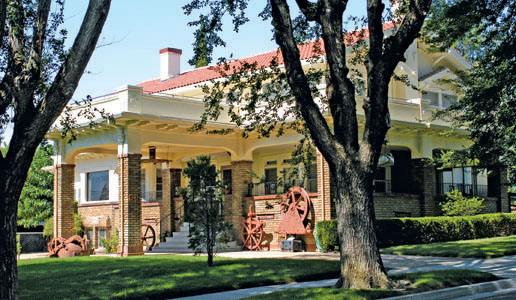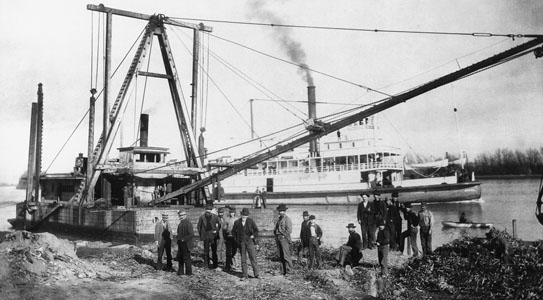For more than 133 years, the Dutra family has been associated with dredging: first of the Sacramento Delta and San Francisco Bay and more recently for bodies of water stretching from Alaska to the Gulf of Mexico.

The Dutra Museum of Dredging at 345 Gertrude Ave. in Rio Vista. Photo by Patty Dutra
By Wes Starratt, PE
Published: June, 2011
For more than 133 years, the Dutra family has been associated with dredging: first of the Sacramento Delta and San Francisco Bay and more recently for bodies of water stretching from Alaska to the Gulf of Mexico. They have also established what is most likely the first and only museum dedicated to dredging, which can be found in the charming City of Rio Vista along the Sacramento River in the Delta.
Dedicated to more than just dredging, the museum also depicts the history of the Sacramento Delta. Once the most vibrant transportation corridor in California, the Delta carried passengers and cargo in riverboats between the thriving port city of San Francisco and the capitol city of Sacramento in the agricultural Central Valley. And central to the maintenance of transportation in the corridor was the dredging of ship channels through the Delta that connected the two communities—that is where the Dutras came into prominence.
By the end of the nineteenth century the new transcontinental railroads had completely bypassed the Delta by crossing the Carquinez Straight, first by rail ferry at Benicia and some years later by a railroad bridge at the same location to the higher ground north of the Delta. Once the railroads reached San Francisco Bay, they found another problem: the shallow San Francisco Bay that lay between Oakland and San Francisco. Again dredges were called to the rescue, and a whole fleet of dredges was designed to open up the shallow waters of the East Bay to commuter railroads. Many of those dredge designs were incorporated into dredging operations in the Delta.
Almost one hundred years later, in the 1950s, came the freeways that totally bypassed the Delta and the Sacramento River by traversing higher ground to the north and crossing at the Carquinez Strait. Thus, one could drive from the Bay Area to the Central Valley without even knowing that there was a Delta there, and today we have what could really be called the Lost Delta that many California residents do not know even exists.
So, the message of the Dutra Museum of Dredging is not only to describe how the Dutra family pioneered dredging throughout the entire Pacific Coast, but also to help rediscover the entire area.
California’s Lost Delta
So, get in your car, reach for your map, and head out on some beautiful two-lane roads that follow the Sacramento River from the San Francisco Bay eastward past Mt. Diablo and into the rich agricultural land where much of our corn and asparagus is grown. You have reached the lush Sacramento Delta, where you will find many roads along the winding levees that protect low-lying farmlands from the higher ship channels. Before long, you will see a sparkling silver tower-bridge that abruptly crosses the river and the channel leading to the Port of Sacramento. On the other side lies the charming town of Rio Vista, which really does have a nice view of the river.
You will immediately see evidence of the continuing presence of the Dutras from the scores of barges, tugs, scows, and dredges tied at moorings along the river. Not far away, up a small hill, at 345 Gertrude Avenue, you will come upon a beautiful old home with a sparkling green lawn. It’s the Dutra Museum of Dredging, and was the original home of the Dutra family.
I was warmly greeted by Patty Dutra, a fifth-generation member of the family and her aunt, Janet Bennett. Both have been deeply involved in organizing the museum, collecting thousands of documents, and putting together the numerous exhibits that occupy the spacious two-story structure.
But before heading for the museum, there are a couple of things that you should know. First of all, you should schedule your tour and make reservations by calling (415) 258-6876. There is an admission charge of $3 for adults and $2 for seniors and students. And try to get some friends together, because groups are encouraged.
A Little Dredging History
As noted earlier, there was a time before the freeways and railroads were built when you needed to book passage on a riverboat to reach Sacramento from San Francisco. At the same time, there was a fleet of dredges to keep channels open and build levees so that all of the soil that washed down from almost 1,000 miles of Sierra-Nevada Mountains would not impair shipping nor cause flooding of the rich farmlands of the Delta.
In the meantime, gold miners, eager to increase their earnings from the meager gold nuggets that they were able to recover from time to time by primitive stream-bed panning, turned to hydraulic mining. Whole hillsides were washed away and into sluice boxes where substantially larger amounts of gold could be recovered. That was fine for the miners, but it was not fine for the farmers in the Delta who were inundated with mud, which clogged channels and breached levees. This situation created a thriving market for dredging, and that is where our Dutra story begins.
The Dutra Story
We turn to the great flood of 1878 that destroyed crops and buildings in the settlements along the Sacramento River. One family of Portuguese origin responded by sending its four sons out to become dredgemen. And so they became dredgemen from one generation to another for the next 133 years. Now with Bill T. Dutra at its head, the family tradition continues.
That story and the dynamic efforts that have been made to maintain the rich farmlands of the Delta, as well numerous diversified designs for dredges, are depicted in pictures, displays, and exhibits in the lovely home that houses the Dutra Museum of Dredging. I believe you will richly enjoy it.

The dredge Atlas was crewed by members of the Dutra family from 1892 to 1896. It is shown here with the Southern Pacific passenger stern-wheeler Modoc during her daily run between Sacramento and San Francisco. Photo courtesy of Dutra Museum of Dredging

The earliest documented use of a clam-shell dredge in levee construction was to build levees at Bouldin Island in the Lisbon District in 1879. Photo courtesy of Dutra Museum of Dredging

